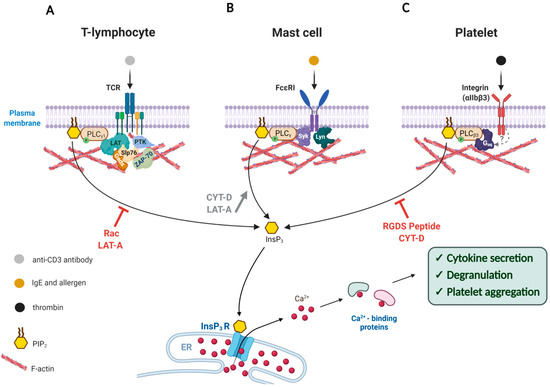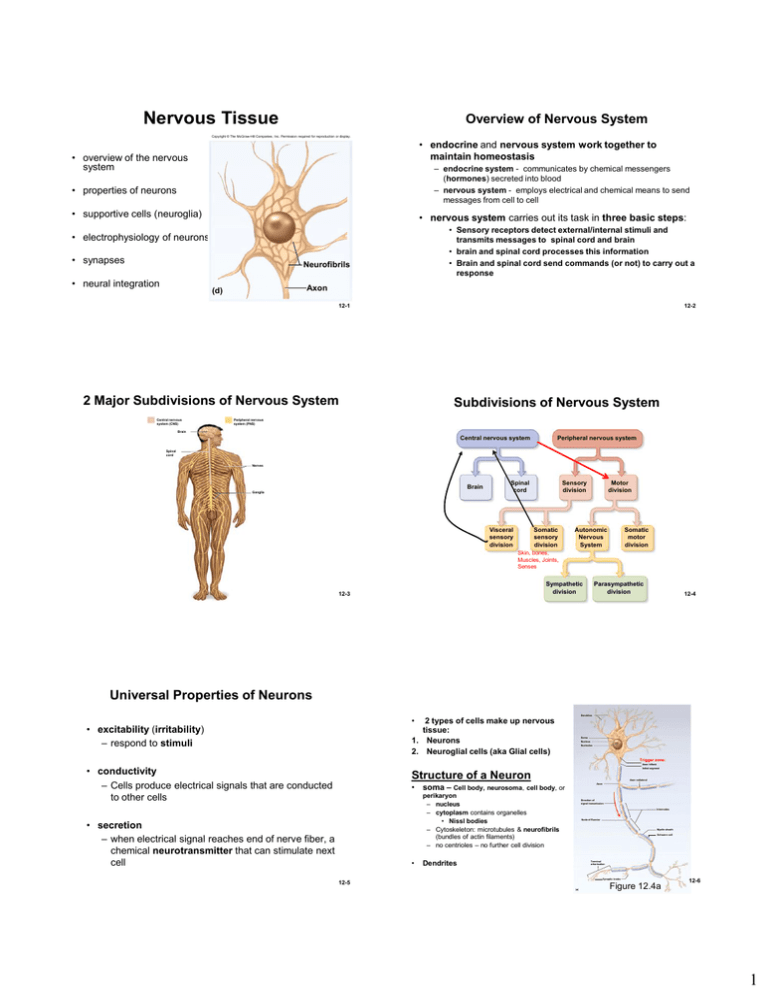Which Cells Are Excitable and Produce Electrical Signals
Nervous systems are composed of two types of cells neurons and glial cells. Receiving and responding to stimuli Producing and sending electrochemical impulses.

Ch 7 The Nervous System 7 1 Ppt Download
In photoreceptors olfactory neurons and some gustatory receptors these channels essentially report the results of antecedent events in a cascade of chemical reactions.

. The neuron illustrated on the following page is a motor neuronthat is it controls muscle fibers. ¾Excitable tissues able to produce electric signals Nerve muscle cells ¾Electric signals brought about by changes in polarization 1. Excitable cells also produce smaller and slower signals called potentials Electrical graded action Chemical action.
Two of the four primary tissue types contain excitable cells cells that receive stimuli and generate electrical signals. In photoreceptors olfactory neurons and some gustatory receptors these channels essentially report the results of antecedent events in a cascade of chemical reactions. Cell body Dendrites Axon hillock Axon and its terminals Gather and transmit information by.
The neurons are excitable as we have said but the glial cells typically are not. As in other excitable cells the ion channels of sensory receptors produce electrical signals that constitute the cellular response to stimulation. Cell membrane and cell excitation Human physiology Summary Excitable cells muscle nerve cells Nerve cells and other cells have resting membrane potential of -70 mV K leak channels Na K ATPase Voltage gated Na channels open to allow Na entry down electrical and concentration gradients membrane depolarisation local non-propagated response or AP.
A neuron or nerve cell is a cell that is specially adapted to. Asked Nov 23 2018 in Anatomy Physiology by Pasito. Nerve cells Muscle cells.
A typical neuron consists of a cell body with fibers called dendrites that bring signals to the cell and a long fiber called the axon that carries the output signal. Which following types of cells are considered excitable cells because they are able to produce electrical signals. Incorrect Question 4 01 pts Which cells are considered excitable cells because they are able to produce electrical signals.
Stronger currents lead into a region of repetitive firing. In muscle cells this electric phenomenon is also associated with the contraction of the cell. Myofibers and neurons The pubic symphysis and intervertebral discs are composed of this type of connective tissue.
The tissues that isare considered excitable because of the ability to generate electrical signals isare called asked Nov 23 2018 in Anatomy Physiology by Pasito A muscle tissue neural tissue and epithelial tissue. In muscle cells this electric phenomenon is also associated with the contraction of the cell. The origin of the membrane voltage is the same in nerve cells as in muscle cells.
A neuroglial cells and myofibers b. These fluctuations may be small and local to a region of a cell membrane often called local or graded potentials or larger in magnitude and travel along the length of the cell. We will discuss action potentials in more detail in Concept 342.
The origin of the membrane voltage is the same in nerve cells as in muscle cells. Electrical signals of excitable cells study guide by michelle_vangi_wong includes 35 questions covering vocabulary terms and more. Such signals are called potentials.
Electromedicine or electromagnetic medicine are the terms applied to such developments in the ELF LF RF IR visible or UV band. Duchenne Electrical stimulation of muscle 1913 early ECG recording. Which of the following types of cells are considered excitable cells because they are able to produce electrical signals.
The tissue s that isare considered excitable because of the ability to generate electrical signals isare called. Nerve cells and muscle cells are excitable. Their cell membrane can produce electrochemical impulses and conduct them along the membrane.
As in other excitable cells the ion channels of sensory receptors produce electrical signals that constitute the cellular response to stimulation. Switching on the signal produces a single AP at the threshold current. Electrical signal in a nerve cell neuron Best demonstrated in the nervous system through the generation of nerve impulse called action potentials Neurons typically have four structures.
Nerve cells and muscle cells are excitable. Reactions of nerve fibers to high frequency electrical stimulation are examined with three nerve models. Excitable cells are cells that can produce large and rapid signals.
Their cell membrane can produce electrochemical impulses and conduct them along the membrane. Quizlet flashcards activities and. High frequency electrostimulation of excitable cells.
Anatomy and Physiology questions and answers. Excitable cells like neurons and muscle have a membrane potential that can fluctuate under certain conditions with each fluctuation representing a signal produced by the cell. Neuroglial cells and muscle cells muscle cells and fibroblasts neuroglial cells and neurons neurons and gap junctions muscle cells and neurons.
Hyperpolarization Figure 41 Page 100 Upward deflection Decrease in potential Downward deflection Increase in potential Resting potential Depolarization Repolarization. Cells that produce electrical signals when stimulated are called Excitable Tissues. The axon may be modeled as an electrical circuit.
Neurons are specialized to produce electric signals.

Schema Of The Probable Pathways Of The Influence Of Electrical Signals Download Scientific Diagram

Nerve Cells And Electric Signaling Anatomy And Physiology Physiology Medical Laboratory Science

Neuron Action Potentials The Creation Of A Brain Signal Article Khan Academy

Neurons A Nerve Cell Capable Of Generating And Transmitting Electrical Signals Vary In Structure And Properties Use The Same Basic Mechanisms To Send Signals Ppt Download

Excitable Membranes What Is An Excitable Membrane Any Plasma Membrane That Can Hold A Charge And Propagate Electrical Signals Ppt Download

Neurons A Nerve Cell Capable Of Generating And Transmitting Electrical Signals Vary In Structure And Properties Use The Same Basic Mechanisms To Send Signals Ppt Download

Neurons A Nerve Cell Capable Of Generating And Transmitting Electrical Signals Vary In Structure And Properties Use The Same Basic Mechanisms To Send Signals Ppt Download

Scheme Of The Signaling Pathways Triggered By Electrical Signals Download Scientific Diagram

Ion Channel Learn Science At Scitable

Ijms Free Full Text Signaling Enzymes And Ion Channels Being Modulated By The Actin Cytoskeleton At The Plasma Membrane Html

Neuronal Calcium Signaling Neuron

Nervous Tissue Overview Of Nervous System

Schemes Of Some Models Of Propagation Of Electrical Signals A Model Of Download Scientific Diagram

Pdf Electrical Signals In Plants Facts And Hypotheses

Researchers Map How Obesity Starts And Is Regulated By The Brain Leptin Obesity Medical News

Sending Biochemical Signals In Cells A Schematic Of A Biochemical Download Scientific Diagram

Study Maps Neurogenetics Of Dendritic Growth And Formation Personalized Medicine Precision Medicine Molecular Biologist


Comments
Post a Comment